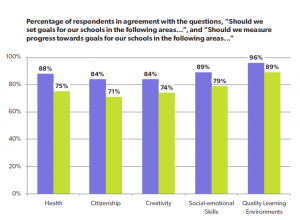Measuring What Matters: A field guide to field trials
For the past three years, People for Education has been engaged in a project to develop broader goals and measures of success in education.
We know that, to be successful in their lives, Ontario’s students need skills beyond literacy and numeracy. We also know that what gets measured gets done. Right now, we only measure literacy and numeracy, and as a result, political and public focus has been on reading, writing and math.
So how can we make sure that students are gaining skills beyond the 3Rs?
The first step: Identifying what matters

In a public survey of over 4000 people, the majority agreed we should set goals for our schools in the areas of health, citizenship, creativity, social-emotional Skills, and quality learning environments, in addition to literacy, numeracy and graduation rates
What are the skills that students need to be successful in school and in life? The first year of the Measuring What Matters project focused on identifying those skills. We conducted public surveys, ran focus groups with parents, teachers, and students, consulted with education experts, and sought input from private and public sector employers. You can read more about what we heard here.
The consultations identified four key areas (“domains”) that have a significant impact on future success:
- Physical and mental health
- Social-emotional skills
- Creativity and innovation
- Citizenship
It was also recognized that the quality of the learning environment has an impact on students’ capacity to develop these skills.
Step 2: Diving Deeper into the Domains
Once the key learning areas were identified, we asked leading experts to write papers that clearly defined the domains, their importance in terms of student success, and some potential ways of measuring student progress. The domains were also looked at in terms of their value from Indigenous and French-language education perspectives:
- Bruce Ferguson – physical and mental health
- Stuart Shanker – social-emotional skills
- Rena Upitis – creativity and innovation
- Alan Sears – citizenship
- Nina Bascia – quality learning environments
- Pamela Toulouse – Indigenous perspective
- Michelle Boucher – French-language systems
Step 3: Making it work for teachers and schools
While there is broad recognition that students need to develop skills in these areas, the bigger challenge is finding a way to assess student progress, given the complex nature of concepts like ‘creativity’ and ‘social-emotional development’.
So we asked our experts to develop a set of school conditions and student competencies that represent the broad, foundational skills in each of the four domains. The draft set of 94 competencies has been posted online. Some examples include:
- Creativity: “Students seek new resources to answer emerging questions.”
- Citizenship: “Students understand how they can influence change(s) in society through participation.”
- Social-emotional learning: “Students develop adaptability and flexibility.”
- Health: “Students have the capacity to manage risks and make good decisions regarding their sexuality.”
- Learning conditions: “The school ethos promotes mutual respect and equality of opportunity and encourages the active participation of pupils in all aspects of school life.”
The goal of developing this set of competencies and skills was that it could be used as a tool for planning, teaching and assessment. But first, they needed to be tested, analyzed, and refined.
Step 4: Testing 1,2,3
Over the last year, People for Education has partnered with 80 educators in 26 schools across 7 Ontario school boards to field test the use of the competencies. This collaborative field work is playing a critical role in furthering our understanding of teaching, learning and assessment practices in these areas, and of the learning conditions that support them.
One of the things that we have learned from the field trials is that having a set of specific, concrete competencies provides a ‘learning language’ for the educators engaged in the trials. It allows teachers to articulate and unpack what are often big, nebulous ideas like “imagination” or “student engagement” or “self-awareness”. This supports specific and actionable practices in the classroom, and enables them to more easily communicate about these complex areas, both with each other and across diverse student age ranges and contexts.
Next Steps:
This year, we will be continuing and expanding the field trials, as we work to refine the competencies and conditions. We will also begin to explore what kind of system change would be needed to support both measurement at the provincial level and assessment at the classroom level. A report on our findings so far will be released this fall, and you can hear from some of the field trial participants at our conference in November.
